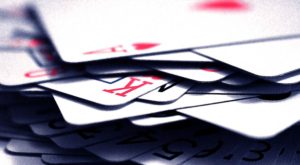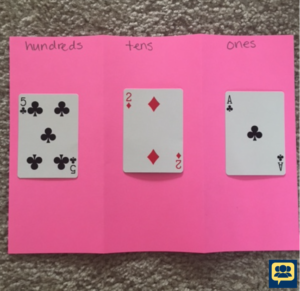Helping prepare your child for Kindergarten doesn’t have to be stressful or boring. Here are 10 ways that you can have fun with your child and help her build her mathematical thinking with a simple deck of playing cards! I’m sure that you’re used to playing games like Go Fish and War, but here are a few more that you can add to your list to help your child practice some basic math skills.

Note: For each of these games you will need to remove the face cards from the deck (King, Queen, Jack and Jokers).
1) Flash
In this game you hold the entire deck of cards face down, and then pull a single card off the top to show to your child. Once you flash the card, your child simply yells out the number on the card.
Variations:
- You can ask your child to call out the number AND the color of the card
- Instead of saying the number on the card, you can have your child say the number plus one (so, if the card is a 5, your child says 6)
- You can also have your child double the number on the card (so, if the card is a 4, your child says 8)
2) Card Sort
Have your child sort the cards into different categories – try sorting them by number, color, or by suit.
Variations:
- You can have your child sort into groups of number greater than 5 and numbers less than 5
- Your child can sort into groups of odd and even numbers
- Your child can also try sorting into groups of multiples (so, all of the 3s, 6s, and 9s would go in a group together)
3) Order Up
Remove all of the cards from a specific suit (spades, clubs, hearts or diamonds) and allow your child to practice counting and ordering numbers by placing the cards in order from 1 (ace) to 10!
Variations:
- Include all four suits and have your child order the entire deck
- Have your child put the cards in reverse order – 10 down to 1 (ace)
- Time your child to see how quickly they place all of the cards in the correct order
4) Pattern Play
Use the different suits, colors or numbers to create math patterns and have your child identify the patterns.
ABC (heart, diamond, club, heart, diamond, club)
ABAB (red, black, red, black) and
AABB ( 3, 3, 6, 6, 3, 3, 6, 6)
are all patterns that your child should start to identify and complete
Variations:
- Include face cards to make more complex patterns
- Ask your child to complete and extend specific patterns that you create

5) Make 10
Set out the entire deck of cards face up, and have your child pick out two cards that add to 10. Making ten out of numbers is an important math skill that is going to help your child with addition and subtraction.
Variations:
- Allow your child to select 3 or 4 cards that can add up to ten
6) One More
Hold the entire deck of cards face down and then pull a single card off the top to show to your child. Once you flash the card, ask your child, “What is one more than ______?” So, if the card is 3, you ask, “What is one more than 3?”
Variations:
- Instead of asking your child what’s one more, you can ask your child to provide you with the number that is one less than the number on the card
- You can also ask your child to tell you what number is two more than the number on the card
7) Counting On
Hold the entire deck of cards face down and then pull a single card off the top to show to your child. Once you flash the card, your child should begin to count to ten starting at the NEXT number in sequence. So, if the card is 6, then your child should say, “7, 8, 9, 10.” Counting on is another skill that is going to help your child with addition and subtraction.
Variations:
- Instead of counting up to ten from the number on the card, have your child count down to zero
- Instead of counting by 1, have your child count up by two until she gets to twenty
8) Place Value Math
Remove all of the 10s from the deck, and put down the place value mat (include hundreds, tens, and ones columns). Place the deck of cards face down and have your child draw three cards from the top. Work with your child to place the numbers on the mat in a way that will allow you to create the largest number possible.
Variations:
- Add a thousands column to the place value mat and allow your child to draw four cards instead of three

9) I Spy
Deal the cards face up in a 5 x 8 array. Ask your child to find two numbers next to each other that add to a particular number by saying, “I spy with my little eye, two numbers that add to make _____.” The two cards need to be next to each other (either horizontally or vertically) and once your child finds them, he removes the pair and places them in his pile. As large gaps appear in the array, simply move the cards closer to close the gaps.
Variations:
- Allow your child to find 3 cards that add to a specific number
- Use subtraction as the operation instead of addition
- Allow you child to find pairs that are diagonal in addition to vertical and horizontal

10) Hi – Lo
Place all of the cards in the deck face down and allow your child to draw two cards. Instruct your child to determine if the sum of the two numbers is higher than ten, lower than ten, or equal to ten.
Variations:
- Allow your child to select three cards instead of two
We’d love to see your math fun in action, so if you decide to play any of these games with your little one, be sure to post a pic below or tag us on Facebook at Let’s Talk Education!
